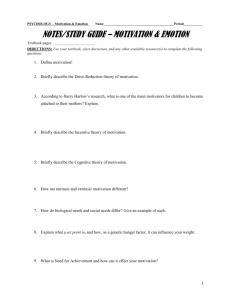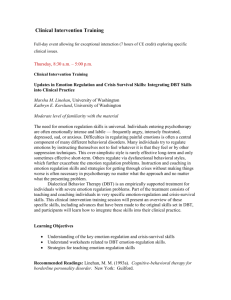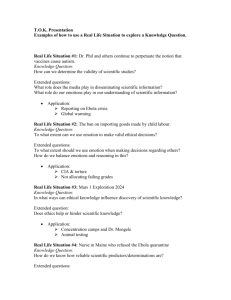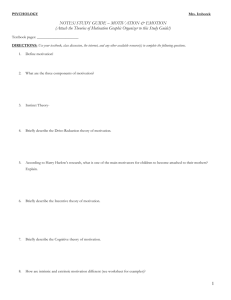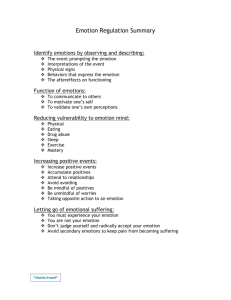Opposite Action pdf
advertisement
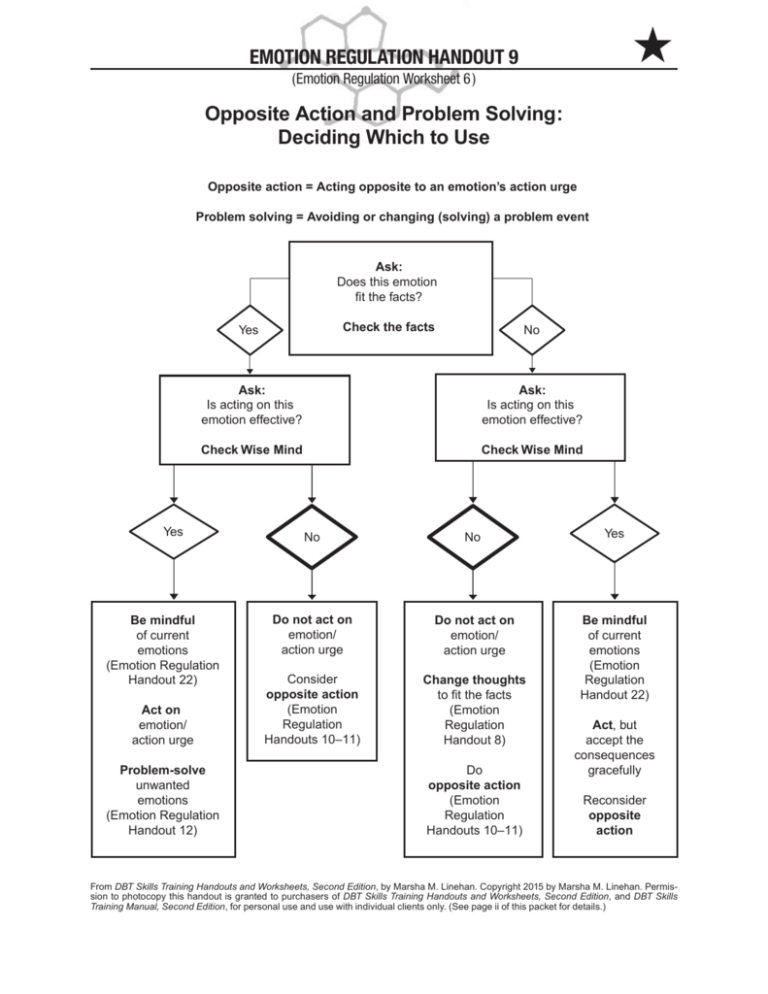
Emotion Regulation Handout 9 (Emotion Regulation Worksheet 6 ) 7 82 .p ; Opposite Action and Problem Solving: Deciding Which to Use Opposite action = Acting opposite to an emotion’s action urge Problem solving = Avoiding or changing (solving) a problem event Ask: Does this emotion fit the facts? Check the facts Yes No Ask: Is acting on this emotion effective? Ask: Is acting on this emotion effective? Check Wise Mind Check Wise Mind Yes Be mindful of current emotions (Emotion Regulation Handout 22) Act on emotion/ action urge Problem-solve unwanted emotions (Emotion Regulation Handout 12) No No Yes Do not act on emotion/ action urge Do not act on emotion/ action urge Consider opposite action (Emotion Regulation Handouts 10–11) Change thoughts to fit the facts (Emotion Regulation Handout 8) Be mindful of current emotions (Emotion Regulation Handout 22) Do opposite action (Emotion Regulation Handouts 10–11) Act, but accept the consequences gracefully Reconsider opposite action From DBT Skills Training Handouts and Worksheets, Second Edition, by Marsha M. Linehan. Copyright 2015 by Marsha M. Linehan. Permission to photocopy this handout is granted to purchasers of DBT Skills Training Handouts and Worksheets, Second Edition, and DBT Skills Training Manual, Second Edition, for personal use and use with individual clients only. (See page ii of this packet for details.) Emotion Regulation Handout 10 (Emotion Regulation Worksheet 7) 88 2 .p ; Opposite Action Use opposite action when your emotions do not fit the facts or when acting on your emotions is not effective. Every emotion has an action urge. Change the emotion by acting opposite to its action urge. Consider these examples: Emotion Action urge Opposite action Fear Run away/avoid Approach/don’t avoid Anger Attack Gently avoid/be a little nice Sadness Withdraw/isolate Get active Shame Hide/avoid Tell the secret to people who will accept it How to Do Opposite Action, Step by Step Step 1. Identify and name the emotion you want to change. Step 2. Check the facts to see if your emotion is justified by the facts. Check also whether the intensity and duration of the emotion fit the facts. (Example: “Irritation” fits the facts when your car is cut in front of; “road rage” does not.) An emotion is justified when your emotion fits the facts. Step 3. Identify and describe your action urges. Step 4. Ask Wise Mind: Is expression or acting on this emotion effective in this situation? If your emotion does not fit the facts or if acting on your emotion is not effective: Step 5. Identify opposite actions to your action urges. Step 6. Act opposite all the way to your action urges. Step 7. Repeat acting opposite to your action urges until your emotion changes. From DBT Skills Training Handouts and Worksheets, Second Edition, by Marsha M. Linehan. Copyright 2015 by Marsha M. Linehan. Permission to photocopy this handout is granted to purchasers of DBT Skills Training Handouts and Worksheets, Second Edition, and DBT Skills Training Manual, Second Edition, for personal use and use with individual clients only. (See page ii of this packet for details.) Emotion Regulation Handout 11 (p. 1 of 9) (Emotion Regulation Worksheet 7) 88 2 .p ; Figuring Out Opposite Actions Fear Fear fits the facts of a situation whenever there is a threat to: A.Your life or that of someone you care about. B.Your health or that of someone you care about. C.Your well-being or that of someone you care about. D.Other example: Follow these suggestions when your fear is not justified by the facts or not effective: Opposite Actions for Fear Do the opposite of your fearful action urges. For example: 1. Do what you are afraid of doing . . . over and over. 2. Approach events, places, tasks, activities, and people you are afraid of. 3. Do things to give yourself a sense of control and mastery over your fears. All-the-Way Opposite Actions for Fear 4. Keep your eyes and ears open and focused on the feared event. Look around slowly; explore. 5. Take in the information from the situation (i.e., notice that you are safe). 6.Change posture and keep a confident voice tone. Keep your head and eyes up, and your shoulders back but relaxed. Adopt an assertive body posture (e.g., knees apart, hands on hips, heels a bit out). 7. Change your body chemistry. For example, do paced breathing by breathing in deeply and breathing out slowly. (continued on next page) From DBT Skills Training Handouts and Worksheets, Second Edition, by Marsha M. Linehan. Copyright 2015 by Marsha M. Linehan. Permission to photocopy this handout is granted to purchasers of DBT Skills Training Handouts and Worksheets, Second Edition, and DBT Skills Training Manual, Second Edition, for personal use and use with individual clients only. (See page ii of this packet for details.) Emotion Regulation Handout 11 (p. 2 of 9) Anger Anger fits the facts of a situation whenever: A.An important goal is blocked or a desired activity is interrupted or prevented. B.You or someone you care about is attacked or hurt by others. C.You or someone you care about is insulted or threatened by others. D.The integrity or status of your social group is offended or threatened. E.Other example: Follow these suggestions when your anger is not justified by the facts or is not effective: Opposite Actions for Anger Do the opposite of your angry action urges. For example: 1. Gently avoid the person you are angry with (rather than attacking). 2. Take a time out, and breathe in and out deeply and slowly. 3. Be kind (rather than mean or insulting). All-the-Way Opposite Actions for Anger 4. Imagine understanding and empathy for the other person. Step into the other person’s shoes. Try to see the situation from the other person’s point of view. Imagine really good reasons for what has happened. 5. Change your posture. Unclench hands, with palms up and fingers relaxed (willing hands). Relax chest and stomach muscles. Unclench teeth. Relax facial muscles. Half-smile. 6. Change your body chemistry. For example, do paced breathing by breathing in deeply and breathing out slowly. Or, run or engage in another physically energetic, nonviolent activity. (continued on next page) Emotion Regulation Handout 11 (p. 3 of 9) Disgust Disgust fits the facts of a situation whenever: A.Something you are in contact with could poison or contaminate you. B.Somebody whom you deeply dislike is touching you or someone you care about. C.You are around a person or group whose behavior or thinking could seriously damage or harmfully influence you or the group you are part of. D.Other example: Follow these suggestions when your disgust is not justified by the facts or is not ­effective: Opposite Actions for Disgust Do the opposite of your disgusted action urges. For example: 1. Move close. Eat, drink, stand near, or embrace what you found disgusting. 2.Be kind to those you feel contempt for; step into the other person’s shoes. All-the-Way Opposite Actions for Disgust 3. Imagine understanding and empathy for the person you feel disgust or contempt for. Try to see the situation from the other person’s point of view. Imagine really good reasons for how the other person is behaving or looking. 4. Take in what feels repulsive. Be sensual (inhaling, looking at, touching, listening, tasting). 5. Change your posture. Unclench hands with palms up and fingers relaxed (willing hands). Relax chest and stomach muscles. Unclench teeth. Relax facial muscles. Half-smile. 6. Change your body chemistry. For example, do paced breathing by breathing in deeply and breathing out slowly. (continued on next page) Emotion Regulation Handout 11 (p. 4 of 9) Envy Envy fits the facts of a situation whenever: A.Another person or group has what you want or need but don’t have. B.Other example: Follow these suggestions when your envy is not justified by the facts or is not effective: Opposite Actions for Envy Do the opposite of your envious action urges. For example: 1. Inhibit destroying what the other person has. 2. Count your blessings. Make a list of the things you are thankful for. All-the-Way Opposite Actions for Envy 3. Count all your blessings. Avoid discounting some blessings. Avoid exaggerating your deprivations. 4.Stop exaggerating others’ net worth or value; check the facts. 5. Change your posture. Unclench hands with palms up and fingers relaxed (willing hands). Relax chest and stomach muscles. Unclench teeth. Relax facial muscles. Half-smile. 6. Change your body chemistry. For example, do paced breathing by breathing in deeply and breathing out slowly. (continued on next page) Emotion Regulation Handout 11 (p. 5 of 9) Jealousy Jealousy fits the facts of a situation whenever: A.Someone is threatening to take a very important and desired relationship or object away from you. B.An important and desired relationship is in danger of being damaged or lost. C.Other example: Follow these suggestions when your jealousy is not justified by the facts or is not ­effective: Opposite Actions for Jealousy Do the opposite of your jealous action urges. For example: 1. Let go of controlling others’ actions. 2. Share the things and people you have in your life. All-the-Way Opposite Actions for Jealousy 3. Stop spying or snooping. Suppress probing questions (“Where were you? Who were you with?”). Fire your “private detective.” 4. No avoiding. Listen to all the details. Focus on sensations. Keep your eyes open; look around. Take in all the information about the situation. 5. Change your posture. Unclench hands with palms up and fingers relaxed (willing hands). Relax chest and stomach muscles. Unclench teeth. Relax facial muscles. Half-smile. 6. Change your body chemistry. For example, do paced breathing by breathing in deeply and breathing out slowly. (continued on next page) Emotion Regulation Handout 11 (p. 6 of 9) Love Love (other than universal love for all) fits the facts of a situation whenever: A.Loving a person, animal, or object enhances quality of life for you or for those you care about. B.Loving a person, animal, or object increases your chances of attaining your own personal goals. C.Other example: Follow these suggestions when your love is not justified by the facts or is not effective: Opposite Actions for Love Do the opposite of your loving action urges. For example: 1. Avoid the person, animal, or object you love. 2. Distract yourself from thoughts of the person, animal, or object. 3. Remind yourself of why love is not justified (rehearse the “cons” of loving) when loving thoughts do arise. All-the-Way Opposite Actions for Love 4. Avoid contact with everything that reminds you of a person you love: pictures, letters/ messages/e-mails, belongings, mementos, places you were together, places you planned to or wanted to go together, places where you know the person has been or will be. No following, waiting for, or looking for the person. 5. Stop expressing love for the person, even to friends. Be unfriendly toward the person (e.g., “unfriend” the person on Facebook, Twitter, etc.). 6. Adjust your posture and expressions if you are around the person you love. No leaning toward him or her. No getting close enough to touch. No sighing/gazing at the person. (continued on next page) Emotion Regulation Handout 11 (p. 7 of 9) Sadness Sadness fits the facts of a situation whenever: A.You have lost something or someone permanently. B.Things are not the way you want or expected and hoped them to be. C.Other example: Follow these suggestions when sadness is not justified by the facts or is not effective: Opposite Actions for Sadness Do the opposite of your sad action (or inaction) urges. For example: 1.Get active; approach. 2. Avoid avoiding. 3. Build mastery: Do things that make you feel competent and self-­confident. (See Emotion Regulation Handout 19: Build Mastery and Cope Ahead.) 4.Increase pleasant events. All-the-Way Opposite Actions for Sadness 5. Pay attention to the present moment! Be mindful of your environment—each detail as it unfolds. Experience new or positive activities you are engaging in. 6. Change your posture (adopt a “bright” body posture, with head up, eyes open, and shoulders back). Keep an upbeat voice tone. 7. Change your body chemistry. For example, increase physical movement (run, jog, walk, or do other active exercise). (continued on next page) Emotion Regulation Handout 11 (p. 8 of 9) Shame Shame fits the facts of a situation whenever: A.You will be rejected by a person or group you care about if your personal characteristics or behavior are made public. B.Other example: Follow these suggestions when both shame and guilt are not justified by the facts or are not effective: Opposite Actions for Shame Do the opposite of your action urges. For example: 1. Make public your personal characteristics or your behavior (with people who won’t reject you). 2. Repeat the behavior that sets off shame over and over (without hiding the behavior from those who won’t reject you). All-the-Way Opposite Actions for Shame 3. No apologizing or trying to make up for a perceived transgression. 4. Take in all the information from the situation. 5. Change your body posture. Look innocent and proud. Lift your head; “puff up” your chest; maintain eye contact. Keep your voice tone steady and clear. Follow these suggestions when shame is not justified by the facts or is not effective, but guilt is justified (your behavior does violate your own moral values): Opposite Actions for Shame Do the opposite of your action urges. For example: 1. Make public your behavior (with people who won’t reject you). 2. Apologize for your behavior. 3. Repair the transgressions, or work to prevent or repair similar harm for others. 4. Commit to avoiding that mistake in the future. 5. Accept the consequences gracefully. All-the-Way Opposite Actions for Shame 6. Forgive yourself. Acknowledge the causes of your behavior. 7. Let it go. (continued on next page) Emotion Regulation Handout 11 (p. 9 of 9) Guilt Guilt fits the facts of a situation whenever: A.Your behavior violates your own values or moral code. B.Other example: Follow these suggestions when both guilt and shame are not justified by the facts or are not effective: Opposite Actions for Guilt Do the opposite of your action urges. For example: 1. Make public your personal characteristics or your behavior (with people who won’t reject you). 2. Repeat the behavior that sets off guilt over and over (without hiding the behavior from those who won’t reject you). All-the-Way Opposite Actions for Guilt 3. No apologizing or trying to make up for a perceived transgression. 4. Take in all the information from the situation. 5. Change your body posture. Look innocent and proud. Lift your head; “puff up” your chest; maintain eye contact. Keep your voice tone steady and clear. Follow these suggestions when guilt is not justified by the facts or is not effective but shame is justified (you will be rejected by people you care about if found out): Opposite Actions for Guilt 1. Hide your behavior (if you want to stay in the group). 2. Use interpersonal skills (if you want to stay in the group). 3. Work to change the person’s or group’s values. 4. Join a new group that fits your values (and will not reject you). 5. Repeat the behavior that sets off guilt over and over with your new group. All-the-Way Opposite Actions for Guilt 6. Validate yourself. Emotion Regulation Handout 12 (Emotion Regulation Worksheet 8 ) 092–982 . pp ; Problem Solving Step 1. Figure out and describe the problem situation. Step 2. Check the facts (all the facts) to be sure you have the right problem ­situation! If your facts are correct and the situation is the problem, continue with Step 3. If your facts are not correct, go back and repeat Step 1. Step 3. Identify your goal in solving the problem. •• Identify what needs to happen or change for you to feel OK. •• Keep it simple, and choose something that can actually happen. Step 4. Brainstorm lots of solutions. •• Think of as many solutions as you can. Ask for suggestions from people you trust. •• Do not be critical of any ideas at first. (Wait for Step 5 to evaluate ideas.) Step 5. Choose a solution that fits the goal and is likely to work. •• If you are unsure, choose two solutions that look good. •• Do pros and cons to compare the solutions. •• Choose the best to try first. Step 6. Put the solution into action. •• Act! Try out the solution. •• Take the first step, and then the second . . . Step 7. Evaluate the results of using the solution. It worked? Yea!!! It didn’t work? Go back to Step 5 and choose a new solution to try. From DBT Skills Training Handouts and Worksheets, Second Edition, by Marsha M. Linehan. Copyright 2015 by Marsha M. Linehan. Permission to photocopy this handout is granted to purchasers of DBT Skills Training Handouts and Worksheets, Second Edition, and DBT Skills Training Manual, Second Edition, for personal use and use with individual clients only. (See page ii of this packet for details.) Emotion Regulation Worksheet 6 (Emotion Regulation Handout 9) Figuring Out How to Change Unwanted Emotions Due Date: Name: Week Starting: Once you have checked the facts, use this worksheet to help you figure out what to do next. Before you can figure out what to change, you have to decide whether acting on your emotion is effective in the situation you are in (and whether the emotion is one you actually want to change). (If you are not sure whether you want to change it or not, go back to Emotion Regulation Worksheet 1 and do pros and cons.) In the flow chart below, circle Yes or No at each level, and then select the skill that fits your situation best. Emotion Name: Ask: Does this emotion fit the facts? ________________ Yes No Check the facts Ask: Is acting on this emotion effective? Ask: Is acting on this emotion effective? Check Wise Mind Check Wise Mind Yes Be mindful of current emotions (Emotion Regulation Handout 22) Act on emotion/ action urge No No Yes Do not act on emotion/ action urge Do not act on emotion/ action urge Consider opposite action (Emotion Regulation Handouts 10–11) Change thoughts to fit the facts (Emotion Regulation Handout 8) Be mindful of current emotions (Emotion Regulation Handout 22) Problem-solve unwanted emotions (Emotion Regulation Handout 12) Do opposite action (Emotion Regulation Handouts 10–11) Act, but accept the consequences gracefully Reconsider opposite action Describe what you did to manage the emotion: From DBT Skills Training Handouts and Worksheets, Second Edition, by Marsha M. Linehan. Copyright 2015 by Marsha M. Linehan. Permission to photocopy this worksheet is granted to purchasers of DBT Skills Training Manual, Second Edition, for personal use or use with individual clients only. (See page ii of this packet for details.) Emotion Regulation Worksheet 7 (Emotion Regulation Handouts 10, 11) Opposite Action to Change Emotions Due Date: Name: Week Starting: Select a current or recent emotional reaction that you find painful or want to change. Figure out if the emotion fits the facts. If it does not, then notice your action urges; figure out what would be opposite actions; and then do the opposite actions. Remember to practice opposite action all the way. Describe what happened. Emotion Name: Intensity (0–100) Before: After: Prompting event for my emotion (who, what, when, where): What prompted the emotion. Is my emotion (or its intensity or duration) justified? Does it fit the facts? Is it effective? List the facts that justify the emotion and those that do not. Check the answer that is mostly correct. Justified Not justified Justified: Go to problem solving (Emotion Regulation Worksheet 8) Not justified: Continue Action urges: What do I feel like doing or saying? Opposite action: What are the actions opposite to my urges? What am I not doing because of my emotions? Describe both what and how to act opposite all the way in the situation. What I did: Describe in detail. How I did it: Describe body language, facial expression, posture, gestures, and thoughts. What aftereffect did the opposite action have on me (my state of mind, other emotions, behavior, thoughts, memory, body, etc.)? From DBT Skills Training Handouts and Worksheets, Second Edition, by Marsha M. Linehan. Copyright 2015 by Marsha M. Linehan. Permission to photocopy this worksheet is granted to purchasers of DBT Skills Training Manual, Second Edition, for personal use or use with individual clients only. (See page ii of this packet for details.)

